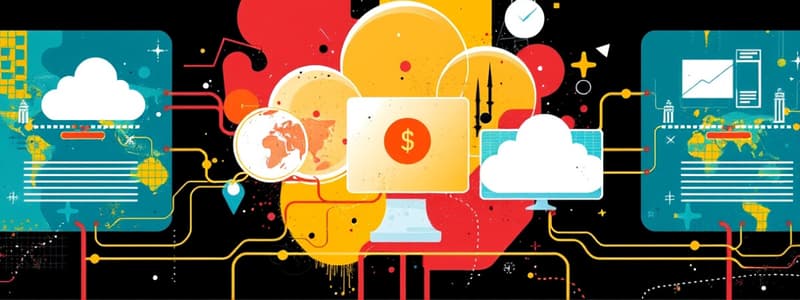Podcast
Questions and Answers
Which module of an ERP system is responsible for managing financial transactions and accounting processes?
Which module of an ERP system is responsible for managing financial transactions and accounting processes?
- Customer Relationship Management
- Human Resources
- Financial Management (correct)
- Manufacturing and Supply Chain Management
What is the main function of a Transaction Processing System (TPS)?
What is the main function of a Transaction Processing System (TPS)?
- Providing strategic insights through data analytics
- Managing human resource functions like payroll and recruitment
- Processing routine transactions such as sales and payroll (correct)
- Integrating marketing activities and customer interactions
Which type of information system provides analytics tools for data-driven decision-making?
Which type of information system provides analytics tools for data-driven decision-making?
- Management Information System
- Transaction Processing System
- Business Intelligence (correct)
- Customer Relationship Management
What is the primary purpose of the Customer Relationship Management (CRM) module in an ERP system?
What is the primary purpose of the Customer Relationship Management (CRM) module in an ERP system?
What role do processes serve in the context of information systems?
What role do processes serve in the context of information systems?
What is the primary objective of Decision Support Systems (DSS)?
What is the primary objective of Decision Support Systems (DSS)?
Which statement accurately describes Enterprise Resource Planning (ERP) systems?
Which statement accurately describes Enterprise Resource Planning (ERP) systems?
Which component of information systems includes the physical infrastructure such as servers and storage devices?
Which component of information systems includes the physical infrastructure such as servers and storage devices?
Business Process Management (BPM) solutions are intended for what primary function?
Business Process Management (BPM) solutions are intended for what primary function?
Which example correctly represents Data Access Middleware?
Which example correctly represents Data Access Middleware?
Which system primarily supports mid-level management decision-making by providing reports on operational data?
Which system primarily supports mid-level management decision-making by providing reports on operational data?
Which of the following describes Service-Oriented Architecture (SOA)?
Which of the following describes Service-Oriented Architecture (SOA)?
Which of the following options best describes the focus of an information-oriented approach?
Which of the following options best describes the focus of an information-oriented approach?
What is a primary function of enterprise portals?
What is a primary function of enterprise portals?
Which type of middleware is designed to manage complex distributed transactions?
Which type of middleware is designed to manage complex distributed transactions?
What is the key purpose of customer portals?
What is the key purpose of customer portals?
Which characteristic best represents information-oriented integration?
Which characteristic best represents information-oriented integration?
What is a critical aspect of user interface design for enterprise portals?
What is a critical aspect of user interface design for enterprise portals?
Which middleware type is used for asynchronous communication between applications?
Which middleware type is used for asynchronous communication between applications?
What is an essential consideration when implementing security for enterprise portals?
What is an essential consideration when implementing security for enterprise portals?
Which of the following represents a function related to content management in enterprise portals?
Which of the following represents a function related to content management in enterprise portals?
Flashcards are hidden until you start studying
Study Notes
Enterprise and Customer Portals
- Enterprise portals provide a centralized access point for employees to access applications, information, and services.
- Customer portals enable self-service functionalities and information access for customers and partners.
- Vertical portals target specific industries, aggregating relevant information and resources.
Middleware Types and Functions
- Message Oriented Middleware (MOM) enables asynchronous communication between applications using messages, with examples like JMS and RabbitMQ.
- Transaction Processing Monitors (TPM) manage complex distributed transactions and ensure coordination; notable examples include IBM CICS and Oracle Tuxedo.
- Application Servers create a runtime environment for deploying enterprise applications, with prominent examples being JBoss and WebLogic.
- Data Access Middleware facilitates interaction with databases and data sources, including tools like JDBC and ODBC.
Information System Components
- Hardware encompasses all physical components such as computers and networking equipment.
- Software includes operating systems, application software, and database management systems vital for system operation.
- Data refers to the raw facts processed and stored by the information system.
- People comprise users, analysts, developers, and database administrators involved in system management.
- Processes define the procedures to transform data into meaningful information.
- Procedures document the steps for effective system usage.
Types of Information Systems
- Transaction Processing Systems (TPS) handle routine transactions such as sales and payroll.
- Management Information Systems (MIS) generate reports for mid-level management to support decisions.
- Decision Support Systems (DSS) provide analytical tools to assist complex decision-making.
- Enterprise Resource Planning (ERP) systems integrate essential business processes across the organization, covering finance, HR, manufacturing, and CRM.
Benefits of Information-Oriented Approaches
- Information-oriented integration offers simple and efficient data transfer mechanisms for straightforward needs.
- This approach proves cost-effective, reducing development efforts compared to other integration methods.
- Business Process Management (BPM) solutions model, automate, optimize, and monitor business processes across systems.
- Service-Oriented Architecture (SOA) modularizes functionalities into reusable services, allowing diverse applications to collaborate effectively.
Studying That Suits You
Use AI to generate personalized quizzes and flashcards to suit your learning preferences.




